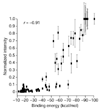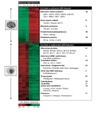Expression profiling of the schizont and trophozoite stages of Plasmodium falciparum with a long-oligonucleotide microarray
- PMID: 12620119
- PMCID: PMC151308
- DOI: 10.1186/gb-2003-4-2-r9
Expression profiling of the schizont and trophozoite stages of Plasmodium falciparum with a long-oligonucleotide microarray
Abstract
Background: The worldwide persistence of drug-resistant Plasmodium falciparum, the most lethal variety of human malaria, is a global health concern. The P. falciparum sequencing project has brought new opportunities for identifying molecular targets for antimalarial drug and vaccine development.
Results: We developed a software package, ArrayOligoSelector, to design an open reading frame (ORF)-specific DNA microarray using the publicly available P. falciparum genome sequence. Each gene was represented by one or more long 70 mer oligonucleotides selected on the basis of uniqueness within the genome, exclusion of low-complexity sequence, balanced base composition and proximity to the 3' end. A first-generation microarray representing approximately 6,000 ORFs of the P. falciparum genome was constructed. Array performance was evaluated through the use of control oligonucleotide sets with increasing levels of introduced mutations, as well as traditional northern blotting. Using this array, we extensively characterized the gene-expression profile of the intraerythrocytic trophozoite and schizont stages of P. falciparum. The results revealed extensive transcriptional regulation of genes specialized for processes specific to these two stages.
Conclusions: DNA microarrays based on long oligonucleotides are powerful tools for the functional annotation and exploration of the P. falciparum genome. Expression profiling of trophozoites and schizonts revealed genes associated with stage-specific processes and may serve as the basis for future drug targets and vaccine development.
Figures







References
-
- PlasmoDB: The Plasmodium Genome Resource http://plasmodb.org
Publication types
MeSH terms
Substances
LinkOut - more resources
Full Text Sources
Other Literature Sources
Miscellaneous

